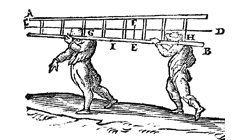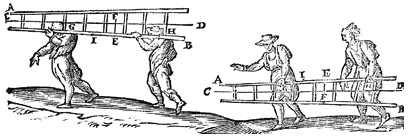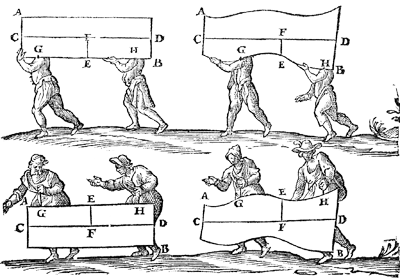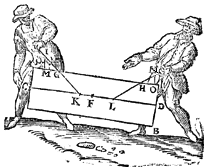
Centre of gravity: F.
GE = HE.
Proposition VIII. |

|
Supposition. Let AB be a ladder, heavier at one end than at the other end, as they usually are, which is to be carried by two men in such a way that one shall carry as much weight as the other, i.e. each one half; and its centre line CD shall remain parallel to the horizon during the carrying. Construction. The ladder shall be laid on a sharp edge and pulled forwards and backwards until equality of apparent weight is found to he attained, which I take to be in E; and if the ladder has to be often carried from one place to another, a notch may be made at E. Thereafter let there be drawn the vertical EF, intersecting CD in F, and then two points shall be marked at equal distances from EF, as G and H; then the man carrying the ladder at G will carry the same weight as the one at H. [ *) Translation from Principal Works, vol. I, p. 333. Figures from DBNL, Wisc. Ghed. 4.]
|

|
And thus the ratio of the weight of the one to that of the other can be fixed according to requirement.
|

|
|

|
|

|
From which it also appears that if the fixed points G, H are below the line CD, the man in front carries least, but if these fixed points are above the line CD, the man in front carries most. It is also evident that if the fixed points G, H are in the line CD, each of the men will then always carry the same weight everywhere, both when ascending a mountain and when walking parallel to the horizon, the proofs of all of which are manifest from the 14th, 15th, 16th, 17th, 18th, 27th, 28th propositions of the 1st book.
Thereafter, equal weights, as E and F, hanging at the stick in such a way that their cords GH, IK are equidistant from the line CD drawn downwards, to wit that HL shall be equal to LK, the stick will keep its first position. It will do the same, if E be taken away and the weight M, double of F, be suspended in such a way that LK shall also be double of LN, and thus with all the others, from which they will easily understand the necessity of what has been said above.
|

|
as MI is to IG, so is the vertical lifting weight along MI to the weight pulled by the man at G, and again as ON is to NH, so is the vertical lifting weight along ON to the weight pulled by the man at H, by the 27 proposition of the 1st book of the elements, and the force exerted by each becomes known from the 22nd proposition of the same book. |